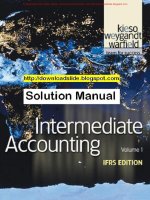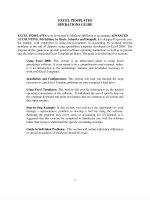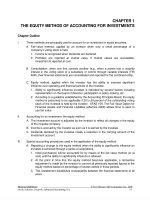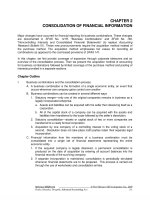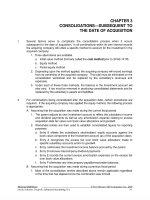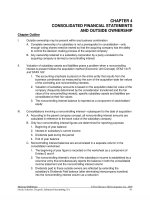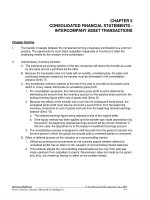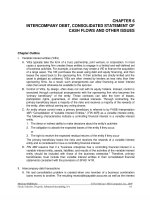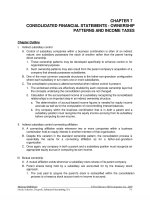Solution manual intermediate accounting 9e by nicolai appendix c
Bạn đang xem bản rút gọn của tài liệu. Xem và tải ngay bản đầy đủ của tài liệu tại đây (1.91 MB, 79 trang )
To download more slides, ebook, solutions and test bank, visit
APPENDIX C
REVIEW OF THE ACCOUNTING PROCESS
CONTENT ANALYSIS OF EXERCISES AND PROBLEMS
Number
Content
Time Range
(minutes)
EC-1
Financial Statement Interrelationship. Diagram.
5-10
EC-2
Journal Entries. Sales, purchases, accounts payable.
5-10
EC-3
Journal Entries. Sales, purchases, accounts payable, accounts
receivable. Post to t-accounts.
5-10
EC-4
Income Statement. Partial through gross profit on sales.
5-10
EC-5
Income Statement. Calculations, fill in the blanks.
5-10
EC-6
Financial Statements. Prepare income statement, retained
earnings statement, balance sheet, closing entries.
EC-7
Adjusting Entries. Bad debts, accruals, deferrals.
EC-8
Adjusting Entries. Recognizing necessary adjustments, journal
entries.
10-15
EC-9
Adjusting Entries. Record changes in trial balance accounts.
5-10
EC-10
Closing Entries. Prepare from ending account balances.
5-15
EC-11
Reversing Entries. Recognizing and preparing appropriate
reversals.
5-15
EC-12
Special Journals. Indicate appropriate journal and account for
various transactions.
10-15
EC-13
Worksheet. Adjustments, income statement, retained earnings
statement, balance sheet. Prepare financial statements from
worksheet.
10-20
EC-14
Worksheet. Adjustments, income statement, retained earnings
statement, balance sheet. Financial statement preparation.
Closing entries.
15-20
EC-15
Cash-Basis Accounting. Prepare accrual-based income
statement and balance sheet from cash-basis accounting
records.
15-20
C-1
10-20
5-15
To download more slides, ebook, solutions and test bank, visit
Number
Content
Time Range
(minutes)
PC-1
Trial Balance. Journal entries, posting to general ledger,
preparing trial balance.
90-120
PC-2
Financial Statements. Periodic inventory system. Preparation of
income statement, retained earnings statement, balance
sheet from trial balance. Closing entries.
30-45
PC-3
Financial Statements. Perpetual inventory system. Preparation
of income statement, retained earnings statement, balance
sheet from trial balance. Closing entries.
30-45
PC-4
Adjusting Entries. Recognize, calculate, journalize adjustments.
Accruals, deferrals, year-end.
15-30
PC-5
Adjusting Entries. Calculate and journalize accruals, deferrals,
and year-end adjustments.
20-40
PC-6
Adjusting Entries. Determine by comparing trial balance and
adjusted trial balance. Prepare necessary reversing entries.
20-40
PC-7
Adjusting Entries. Year-end adjustments to update trial
balance accounts.
20-40
PC-8
Reversing Entries. Note payable, note receivable. Recording
collection, payment with and without reversing entries.
15-30
PC-9
Errors. Effect on net income, total assets, total liabilities, total
stockholders' equity.
15-20
PC-10
Errors in Financial Statements. Indicate effect on net income,
assets, liabilities, and stockholders' equity of various errors.
15-20
PC-11
Reversing Entries. Prepare appropriate reversals and explain
why entries should be reversed.
15-30
PC-12
Special Journals. Various transactions, record in appropriate
journal.
30-40
PC-13
Worksheet. Prepare and complete worksheet. Financial
statements, adjusting and closing entries.
60-90
PC-14
Worksheet. Complete worksheet. Prepare financial
statements, adjusting and closing entries.
75-105
PC-15
Special Journals. Journalize and post various transactions in
appropriate journals and accounts.
45-90
PC-16
Comprehensive. Journal entries, posting, trial balance,
financial statements, adjusting and closing entries.
90-120
PC-17
Comprehensive: Statements From Incomplete Records.
Prepare worksheet and financial statements from checkbook
and other information.
45-90
C-2
To download more slides, ebook, solutions and test bank, visit
Number
PC-18
Content
(AICPA adapted). Comprehensive. Accrual adjustments to
cash-basis records, worksheet, statement of changes in capital.
Time Range
(minutes)
45-90
ANSWERS TO QUESTIONS
QC-1
A primary objective of financial reporting is to provide information that is useful to
present and potential investors and creditors and other users in making rational
investment, credit, and similar decisions.
QC-2
An accounting system is the means by which a company records and stores the
financial and managerial information from its transactions so that it can retrieve and
report the information in an accounting statement. All companies have accounting
systems, ranging in degree of sophistication from the simple to the complex.
QC-3
Assets = Liabilities + Stockholders' Equity
Stockholders' Equity = Contributed Capital + Retained Earnings
Retained Earnings = Beginning Retained Earnings + Net Income - Dividends
Net Income = Revenues - Expenses
QC-4
A double-entry system standardizes the method that a company uses to record
changes in its accounts resulting from various business transactions or events. For
each transaction or event that a company records, the dollar amount of the debits
entered in all the related accounts must be equal to the total dollar amount of the
credits. These debit or credit entries affect two or more accounts in the assets,
liabilities, and stockholders' equity (including the temporary accounts). All normal
accounts on the left side of the accounting equation (assets) are increased by debits
and decreased by credits whereas accounts on the right side of the equation
(liabilities and stockholders' equity) are increased by credits and decreased by
debits.
QC-5
A permanent account is an account whose balance at the end of the accounting
period is carried forward into the next accounting period. Examples: Cash,
Accounts Payable, Capital Stock. A temporary account is an account that is used
temporarily to determine the change in retained earnings that occurred during the
accounting period. The balance in a temporary account is closed out at the end of
the period. Examples: Sales, Purchases, Salaries Expense.
C-3
To download more slides, ebook, solutions and test bank, visit
QC-6
The major financial statements of a company include:
a. The income statement, which summarizes the results of the company's incomeproducing activities for the accounting period.
b. The balance sheet, which summarizes the amounts of the assets, liabilities, and
stockholders' equity of the company on a particular date.
c. The statement of cash flows, which summarizes the cash receipts and cash
payments of the company for the accounting period.
Some companies also have a fourth financial statement for reporting their
comprehensive income.
QC-7
a. An account is used by a company to store the recorded monetary information
from its transactions and events. An account can be in several physical forms
such as a location on a computer disk or a standardized business paper.
b. A contra account is an account established to emphasize a reduction from a
related account.
c. A ledger is the group of accounts for a company.
d. A journal (or document of original entry) is used by a company to initially record
the debit and credit entries to all accounts affected by its transactions.
e. Posting involves transferring the date and debit and credit amounts from the
journal entries to the appropriate debit and credit sides of the applicable
accounts in the general or subsidiary ledger.
QC-8
The advantages to a company of initially recording each transaction in a journal
include the following.
a. Use of a journal helps to prevent errors because all account titles and debit and
credit entries are initially recorded in one place.
b. All the transactional information is recorded in one place, thereby providing a
complete picture of the transaction.
c. Since the transactions are recorded as they occur, the journal also provides a
chronological record of the company's financial transactions.
QC-9
a.
b.
c.
d.
e.
Purchase of land on account
Sale of capital stock for cash
Collection of accounts receivable
Payment of accounts payable
Retirement of capital stock for cash (note: many examples may show a
decrease in an asset and an increase in a contra-stockholders' equity account)
QC-10
a.
b.
c.
d.
Purchase of merchandise on account
Return of defective merchandise for credit
Purchase of merchandise for cash
Return of defective merchandise for cash refund
C-4
To download more slides, ebook, solutions and test bank, visit
QC-11
The steps that a company completes in the accounting cycle include:
a. Recording daily transactions or events in a journal. The daily transactions or
events are recorded in the general journal or the special journal.
b. Posting journal entries to the accounts in the general ledger. The dates and debit
and credit amounts from the journal entries in the general journal and the special
journals are transferred to the appropriate debit and credit sides of the
applicable accounts in the ledger.
c. Preparing and posting adjusting entries. At the end of the accounting period,
certain accounts are updated through the use of an adjusting entry so that
financial statements include the correct amounts for the current period. Those
entries are transferred (by posting) to the appropriate accounts in the ledger just
as the other journal entries are.
d. Preparing the financial statements. After all the adjusting entries have been
posted to the general ledger, an adjusted trial balance is prepared. From the
adjusted trial balance, the income statement, the retained earnings statement,
and the balance sheet are prepared.
e. Preparing and posting closing entries. All the temporary accounts are closed
(their balances are reduced to zero) and the inventory and retained earnings
accounts are updated by closing entries which are posted to the general ledger.
QC-12
For most companies, not all of their accounts are up to date at the end of the
accounting period. Some of these accounts need to be adjusted so that all
revenues and expenses are recorded and the balance sheet accounts have a
correct ending balance. This is accomplished through the use of adjusting entries.
QC-13
A prepaid expense is a good or service purchased by the company for use in its
operations, but which has not been fully consumed by the end of the accounting
period.
Example: Assume the company paid for a two year insurance policy on July 1, in the
amount of $400 and recorded this as Prepaid Insurance. At the end of the year, the
following adjusting entry is necessary:
Insurance Expense [($400
Prepaid Insurance
2) x 1/2]
100
100
A deferred revenue is a payment received by the company in advance for the
future delivery of inventory or performance of services.
Example: Assume the company received 6 months rent, totaling $1,200 in advance
on November 1 and recorded the receipt as Unearned Rent. On December 31, the
following adjusting entry is necessary:
Unearned Rent ($1,200 x 2/6)
Rent Revenue
400
C-5
400
To download more slides, ebook, solutions and test bank, visit
QC-14
An accrued expense is an expense incurred during the accounting period that has
been neither paid nor recorded.
Example: Assume a company pays employees' salaries once a month on the 15th of
the month. The monthly salaries payment is $5,000. On December 31, the following
adjusting entry is necessary:
Salaries Expense ($5,000 x 1/2)
Salaries Payable
2,500
2,500
An accrued revenue is a revenue earned during the accounting period that has
neither been received nor recorded.
Example: Assume a company received a 90-day note receivable dated December
1. The note has a face value of $10,000 and bears an annual interest rate of 12%.
The adjusting entry on December 31 is:
Interest Receivable
($10,000 x 0.12 x 1/12)
Interest Revenue
QC-15
100
100
Examples of adjusting entries used to record estimated items include:
a. Estimation of bad debts: Assume a company adopts a policy of providing
allowance for bad debt losses that is equal to ½% of net sales. In the current
year, the company has net sales of $1,500,000. The adjusting entry on December
31 is:
Bad Debt Expense
($1,500,000 x 0.005)
Allowance for Doubtful Accounts
7,500
7,500
b. Estimation of depreciation expense: The cost of a depreciable asset is
systematically allocated as an expense to each accounting period in which the
asset is used. This allocation process is called depreciation. Assume that on July 1
of the current year, a company purchased certain office equipment for $20,000,
which is estimated to have a useful life of 10 years and a residual value of $500.
Depreciation expense is calculated using the following formula (assuming the
straight-line method is used):
Annual depreciati on
Cost Estimated residual v alue
Estimated serv ice life
On December 31 of the current year, the company records the following
adjusting entry relating to its depreciation expense:
Depreciation Expense
Accumulated Depreciation
[($20,000 - $500) 10 x 1/2]
C-6
975
975
To download more slides, ebook, solutions and test bank, visit
QC-16
A trial balance lists all of the account balances of a company but does not include
the effect of adjusting entries on the accounts. An adjusted trial balance lists all of
the account balances of a company after the adjusting entries have been posted to
the accounts and before closing entries have been made.
Items on an adjusted trial balance can be readily classified as belonging on either
the income statement, retained earnings statement, or balance sheet, and,
therefore, a company's financial statements can be easily prepared by using the
information on the adjusted trial balance.
QC-17
A periodic inventory system requires counting, measuring, or weighing goods at the
end of the accounting period to determine the quantities on hand. Values are then
assigned to these quantities to determine the portion of the recorded costs to be
included in the ending inventory. No record is kept for the cost of inventory which is
sold during the period nor the cost of inventory on hand during the period.
A perpetual inventory system requires the maintenance of records that provide a
continuous summary of inventory items on hand. Inventory increases and decreases
are recorded in the individual inventory accounts, the resulting balances
representing the current amounts on hand.
Under a periodic inventory system, the balance of the beginning inventory account
remains the same throughout the entire period, until it is closed at the end of the
period. When inventories are purchased, the Purchases account is debited and
when inventories are sold, the Inventory account is not adjusted. The cost of goods
sold for the period is calculated by adding the beginning inventory balance to
purchases (net) and subtracting the ending inventory balance. All inventory losses
and errors are buried in the cost of goods sold calculation.
Under a perpetual inventory system, the purchase of goods increases (debits) the
Inventory account. In addition, the Cost of Goods Sold account is increased
(debited) and the Inventory account is decreased (credited) when the goods are
sold. A physical count of the units on hand is made at least once a year to confirm
the inventory balance listed on the books. Variations between the recorded amount
and the amount actually on hand resulting from errors in recording, shrinkage, and
theft may be recognized. The book inventory is adjusted into agreement with the
physical count and the discrepancy is recorded as an adjustment to cost of goods
sold or an operating expense.
QC-18
When a company uses a periodic inventory system, cost of goods sold is computed
as follows:
Beginning inventory
Add: Net purchases (including returns,
allowances, and freight-in; less discounts taken)
Cost of goods available for sale
Less: Ending inventory
Cost of goods sold
C-7
$XX
XX
$XX
(XX)
$XX
To download more slides, ebook, solutions and test bank, visit
QC-19
Closing entries are made by a company at the end of its accounting period to
reduce the balance in each temporary account to zero and to update the retained
earnings and inventory accounts. After the company posts its closing entries, each
temporary account begins the next accounting period with a zero balance, which
makes it easier to summarize the company's net income and dividend information for
the next accounting period. The retained earnings and inventories balances are also
updated and become the next period's beginning balances.
QC-20
Dec.
31
Sales Revenue
Interest Revenue
Purchases Returns and Allowances
Purchases Discounts Taken
Inventory (December 31)
Income Summary
To close the temporary accounts with
credit balances and to record the
ending inventory.
Dec.
31
Income Summary
Sales Returns and Allowances
Sales Discounts Taken
Purchases
Freight-In
Depreciation Expense
Salaries Expense
Rent Expense
Interest Expense
Bad Debt Expense
Utilities Expense
Income Tax Expense
Inventory (January 1)
To close the temporary accounts
with debit balances and to
eliminate the beginning inventory.
Dec.
31
Income Summary
Retained Earnings
To close the income summary balance
(i.e., net income) to retained earnings.
Dec.
31
Retained Earnings
Dividends Distributed
To close the dividends to retained
earnings.
QC-21
Reversing entries are the exact reverse (accounts and amounts) of adjusting entries.
They are usually made at the same time as closing entries but are dated the first day
of the next accounting period. The use of reversing entries is optional; reversing
entries are used to simplify the recording of a later transaction related to the
adjusting entry. The later transaction can be recorded routinely, without the need to
consider the possible impact of the prior adjusting entry.
C-8
To download more slides, ebook, solutions and test bank, visit
QC-21 (continued)
Assume the ABC Company pays employees' salaries every Friday (5-day work week),
the weekly payroll amounts to $6,000, and December 31 falls on Tuesday. The
adjusting, reversing, and payment entries are as follows:
Dec.
31
Salaries Expense
Salaries Payable
To accrue salaries expense
($6,000 x 2/5).
2,400
Jan.
1
Salaries Payable
Salaries Expense
To reverse adjusting entry
relating to salaries payable.
2,400
Jan.
3
Salaries Expense
Cash
To record payment of weekly
salaries.
6,000
2,400
2,400
6,000
QC-22
A worksheet is a large sheet of multicolumn accounting paper prepared by a
company the end of an accounting period to minimize errors, simplify recording in
the general journal of the adjusting and closing entries, and facilitate the preparation
of the financial statements. It consists of a column for listing all the ledger accounts,
and debit and credit columns for the trial balance, adjustments, income statement,
retained earnings statement, and balance sheet. The trial balance is listed with the
current accounts and balances. Year-end adjustments are then initially entered on
the worksheet. The trial balance amount of each account is combined with the
adjustments to that account and carried over to the proper column of the financial
statement in which the account is located. After each column is properly totaled
and checked, financial statements, adjusting entries, and closing entries can be
prepared from the information contained in the worksheet.
QC-23
A subsidiary ledger is a group of accounts, all of which pertain to one specific
company activity, such as the sale or purchase on account. It is common to have
an Accounts Receivable subsidiary ledger and an Accounts Payable subsidiary
ledger. When a subsidiary ledger is used, a control account is maintained in the
general ledger. On any balance sheet date, the balance of a control account must
always be equal to that of the subsidiary ledger. Subsidiary ledgers and control
accounts are used by large companies selling on credit to many customers and
purchasing on credit from many suppliers. If all the customer and supplier accounts
were included in the general ledger, this ledger would substantially increase in size.
In order to reduce the size of the general ledger, minimize errors, divide the
accounting task, and keep up-to-date records of the company's dealings with
charge customers and suppliers, a subsidiary ledger is usually established.
C-9
To download more slides, ebook, solutions and test bank, visit
QC-23 (continued)
Example: Assume a company sells goods on account to three customers, A, B, and
C. During the year, the following transactions occurred and were recorded in a
general journal.
January 15
February 29
April 25
June 7
July 28
September 5
October 21
November 3
December 5
December 22
Sale to A
Sale to B
Collection from A
Sale to C
Collection from B
Collection from A
Collection from B
Sale to C
Sale to A
Collection from C
$1,200
800
500
2,400
400
400
200
1,700
1,500
2,400
The Accounts Receivable control account in the general ledger and the Accounts
Receivable subsidiary ledger accounts will appear as follows:
General Ledger
Accounts Receivable Subsidiary Ledger
Accounts Receivable Control Account
01/15
1,200 04/25
500
02/29
800 07/28
400
06/07
2,400 09/05
400
11/03
1,700 10/21
200
12/05
1,500 12/22
2,400
12/31 Bal
3,700
A
1,200 04/25
1,500 09/05
1,800
500
400
Bal
B
800 07/28
10/21
200
400
200
Bal
C
2,400 12/22
1,700
1,700
01/14
12/05
12/31 Bal
02/29
12/31
06/07
11/03
12/31
QC-24
2,400
Special journals are journals used by a company to record transactions with a similar
characteristic, such as credit sales and cash payments. Advantages of using special
journals are that (1) they allow the accounting task to be divided, (2) they reduce
the time necessary to complete the various accounting activities, and (3) they
provide for a chronological listing of similar transactions. Subsidiary ledgers and
control accounts are often used with special journals. When this occurs, the postings
to the Accounts Receivable control account are made less frequently from the sales
journal and cash receipts journal.
C-10
To download more slides, ebook, solutions and test bank, visit
QC-25
The major special journals and an example of the transactions that are recorded in
each of them are as follows:
(1)
(2)
(3)
(4)
(5)
QC-26
Sales journal-sales of merchandise on account
Purchases journal-purchases of merchandise on account
Cash receipts journal-receipts of cash
Cash payments journal-payments of cash
General journal-adjusting, closing, and reversing entries and other transactions
not recorded in the special journals. Note: The general journal is not a special
journal but is used with special journals as indicated.
A voucher system is designed to provide safeguards over the disbursement of cash.
The use of a voucher system requires that a company: (1) establish a liability
(Vouchers Payable, which replaces Accounts Payable) for each anticipated cash
payment; (2) support each cash payment by a voucher and substantiating
documents to prove the validity of the payment; and (3) make all payments by
check.
In a voucher system, a company uses a voucher register. Each expenditure is initially
recorded in the voucher register as a liability by a credit to Vouchers Payable and a
debit to the associated asset or expense account. Each expenditure is assigned a
voucher number in sequential order and each voucher contains a file of supporting
evidence.
When the company makes payment, an authorization signature is required and a
check is issued. The check number is entered in the voucher register beside the
number of the paid voucher. In this manner, all unpaid vouchers at the end of the
period can be identified as those without an associated check number. Posting from
the voucher register must be made daily and at the end of the period.
QC-27
The common software packages for the financial accounting functions include
programs for accounts receivable, accounts payable, inventory, payroll, the general
ledger, and spreadsheets.
QC-28
Under cash-basis accounting, a company records revenues when it collects cash
from sales and records expenses when it pays cash for its operations. To convert its
cash-basis accounting records to an accrual-based income statement, the
company must adjust its cash receipts to convert them to sales revenues and must
adjust its cash payments to convert them to cost of goods sold and operating
expenses.
C-11
To download more slides, ebook, solutions and test bank, visit
C-12
To download more slides, ebook, solutions and test bank, visit
SOLUTIONS TO EXERCISES
EC-1
Beginning balance sheet:
Income statement:
AS = LB + CC + RE
Rev. - Exp. = NI
Retained earnings statement:
Ending balance sheet:
Where
AS
LB
CC
RE
NI
Div.
Exp.
Rev.
End. RE = Beg. RE + NI - Div.
AS = LB + CC + RE
= Assets
= Liabilities
= Contributed Capital
= Retained Earnings
= Net Income
= Dividends
= Other Expenses
= Revenues
EC-2
May
1
Cash
Sales Revenue
Made cash sales.
6,300
5
Purchases
Accounts Payable
Purchased merchandise on account.
2,000
9
Accounts Receivable
Sales Revenue
Made credit sales.
3,300
13
Sales Salaries Expense
Office Salaries Expense
Cash
Paid salaries.
900
600
C-13
6,300
2,000
3,300
1,500
To download more slides, ebook, solutions and test bank, visit
EC-2 (continued)
May
14
Accounts Payable
Cash
Purchases Discounts Taken
Paid for May 5 purchases less
2% discount.
2,000
18
Equipment
Cash
Accounts Payable
Purchased equipment making a $2,000
down payment and agreed to pay
balance in 60 days.
8,000
21
Purchases
Freight-In
Cash
Purchased merchandise for
cash and paid freight.
600
20
24
Sales Returns and Allowances
Accounts Receivable
Customer returned defective
merchandise for credit.
400
27
Cash
Land
Gain on Sale of Land
Sold land at a gain.
2,600
1,960
40
2,000
6,000
620
400
1,900
700
EC-3
1.
June
3
7
Cash
Accumulated Depreciation:
Office Equipment
Gain on Sale of Office Equipment
Office Equipment
Sold office equipment at a gain.
Accounts Receivable
Sales Revenue
Made credit sales, terms 2/10, n/30.
C-14
700
1,500
2,000
200
2,000
2,000
To download more slides, ebook, solutions and test bank, visit
EC-3 (continued)
1. (continued)
June
10
Purchases
Cash
Purchased merchandise for cash.
1,000
15
Office Equipment
Cash
Notes Payable
Purchased new office equipment,
paying $1,500 and signing a 90-day
note for the difference.
4,000
16
Cash
Sales Discounts Taken
Accounts Receivable
Collected June 7 accounts
receivable less 2% cash discount.
1,960
40
17
Cash
Sales Revenue
Made cash sales.
4,200
20
Purchases
Accounts Payable
Purchased merchandise on account,
terms 2/10, n/30.
2,600
24
Accounts Payable
Purchases Returns and Allowances
Returned defective merchandise for
credit.
200
29
Accounts Payable
Cash
Purchases Discounts Taken
Paid for June 20 purchases less
return and discount.
30
Utility Expense
Cash
Paid the monthly utility bill.
C-15
2,400
210
1,000
1,500
2,500
2,000
4,200
2,600
200
2,352
48
210
To download more slides, ebook, solutions and test bank, visit
EC-3 (continued)
2.
General Ledger
6/01 Bal
6/03
6/16
6/17
6/30 Bal
Cash
12,523 6/10
700 6/15
1,960 6/29
4,200 6/30
14,321
Office Equipment
6/01 Bal
35,860 6/03
6/15
4,000
6/30 Bal
37,860
1,000
1,500
2,352
210
2,000
Notes Payable
6/01 Bal
6/15
6/30 Bal
3,400
2,500
5,900
Sales Revenue
6/01 Bal
6/07
6/17
6/30 Bal
47,872
2,000
4,200
54,072
Gain on Sale of Office Equipment
6/01 Bal
400
6/03
200
6/30 Bal
600
Purchases Discounts Taken
6/01 Bal
6/29
6/30 Bal
6/01 Bal
6/30
6/30 Bal
220
48
268
Utility Expense
1,124
210
1,334
C-16
Accounts Receivable
6/01 Bal 23,052 6/16
6/07
2,000
6/30 Bal 23,052
2,000
Accumulated Depreciation
6/03
1,500
6/01 Bal
10,540
6/30 Bal
9,040
6/24
6/29
Accounts Payable
200 6/01 Bal
2,400 6/20
6/30 Bal
3,500
2,600
3,500
Sales Discounts Taken
6/01 Bal
240
6/16
40
6/30 Bal
280
6/01 Bal
6/10
6/20
6/30 Bal
Purchases
22,354
1,000
2,600
25,954
Purchases Returns and Allowances
6/01 Bal
420
6/24
200
6/30 Bal
620
To download more slides, ebook, solutions and test bank, visit
EC-4
RULE COMPANY
Partial Income Statement
For Year Ended December 31, 2004
Sales revenue
Less: Sales returns and allowances
Sales discounts taken
Net sales
Cost of goods sold
Inventory, 1/1/2004
Purchases
Purchases returns and allowances
Purchases discounts taken
Freight-in
Cost of goods available for sale
Less: Inventory, 12/31/2004
Cost of goods sold
Gross profit on sales
$
600
200
$ 5,300
8,300
(500)
(100)
400
$13,400
(4,100)
$16,200
(800)
$15,400
(9,300)
$ 6,100
EC-5
(1) Sales
Less: Sales returns
Net sales
Less: Cost of goods sold
Gross profit
$220,000
(1,000)
$219,000
(106,000)
$113,000
(2) Cost of goods sold
Add: Ending inventory
Cost of goods available for sale
Less: Purchases
Purchases returns
Beginning inventory
$106,000
48,000
$154,000
$118,000
(2,000)
(3) Gross profit
Less: Expenses
Net income
(116,000)
$ 38,000
$113,000
(65,000)
$ 48,000
(4) Beginning inventory of 2005 = Ending inventory of 2004 = $48,000
C-17
To download more slides, ebook, solutions and test bank, visit
EC-5 (continued)
(5) Beginning inventory
Purchases
Purchases returns
Cost of goods available for sale
Less: Ending inventory
Cost of goods sold
$140,000
(3,000)
(6) Cost of goods sold
Add: Gross profit
Net sales
Add: Sales returns
Sales
EC-6
1.
$ 48,000
137,000
$185,000
(74,000)
$111,000
$111,000
77,000
$188,000
3,000
$191,000
TURTLE COMPANY
Income Statement
For Year Ended December 31, 2004
Sales revenue
Cost of goods sold
Inventory, 1/1/2004
Purchases
Cost of goods available for sale
Less: Inventory, 12/31/2004
Cost of goods sold
Gross profit on sales
Operating expenses
Selling expenses
Administrative expenses
Total operating expenses
Income before income taxes
Income tax expense
Net Income
$7,900
$1,900
4,200
$6,100
(1,800)
$1,800
600
Earnings per share (400 shares)
(4,300)
$3,600
(2,400)
$1,200
(360)
$ 840
$ 2.10
C-18
To download more slides, ebook, solutions and test bank, visit
EC-6 (continued)
2.
TURTLE COMPANY
Statement of Retained Earnings
For Year Ended December 31, 2004
Retained earnings, January 1, 2004
Add: Net income for 2004
$2,500
840
$3,340
(200)
$3,140
Less: Dividends for 2004
Retained earnings, December 31, 2004
3.
TURTLE COMPANY
Balance Sheet
December 31, 2004
Assets
Current Assets
Cash
Accounts receivable (net)
Inventory
Total current assets
Property and Equipment
Equipment
Less: Accumulated depreciation
Total property and equipment
Total Assets
Current Liabilities
Accounts payable
Salaries payable
Income taxes payable
Total current liabilities
$1,700
2,100
1,800
$5,600
$5,400
(1,700)
3,700
$9,300
Liabilities
$2,300
300
360
$2,960
Stockholders' Equity
Contributed Capital
Capital stock (400 shares)
Retained Earnings
Total Stockholders' Equity
Total Liabilities and Stockholders' Equity
C-19
$3,200
3,140
6,340
$9,300
To download more slides, ebook, solutions and test bank, visit
EC-6 (continued)
4.
2004
Dec.
31
Sales Revenues
Inventory (12/31/04)
Income Summary
7,900
1,800
31
Income Summary
Purchases
Selling Expenses
Administrative Expenses
Income Tax Expense
Inventory (1/1/04)
8,860
31
Income Summary
Retained Earnings
840
31
Retained Earnings
Dividends Distributed
200
31
Bad Debts Expense
Allowance for Doubtful Accounts
To provide for possible bad debt
losses ($25,000 x 2%).
500
31
Salaries Expense
Salaries Payable
To record accrued salaries expense.
1,400
31
Depreciation Expense
Accumulated Depreciation
To record depreciation expense for
the year [($30,000 - $2,000) 8].
3,500
31
Insurance Expense
Prepaid Insurance
To recognize expired insurance.
800
31
Interest Receivable
Interest Revenue
To record interest earned but
not collected.
500
9,700
4,200
1,800
600
360
1,900
840
200
EC-7
2004
Dec.
C-20
500
1,400
3,500
800
500
To download more slides, ebook, solutions and test bank, visit
EC-7 (continued)
Dec.
31
Unearned Rent
Rent Revenue
To record rent revenue earned.
1,000
31
Interest Expense
Interest Payable
To record interest accumulated
but not paid.
600
31
Income Tax Expense
Income Taxes Payable
To record income tax expense for the
year ($6,800 - 500 - 1,400 - 3,500 - 800 +
500 + 1,000 - 600 = $1,500 x 30% = $450).
450
31
Depreciation Expense
Accumulated Depreciation
To record depreciation expense for
the year [$(10,000 - 800) 4 x 9/12].
1,725
31
Interest Expense
Interest Payable
To record interest accumulated but
not paid ($9,000 x 12% x 9/12).
810
31
Office Supplies Expense
Office Supplies
To record office supplies used
($250 + $830 - $190 = $890).
890
31
Insurance Expense
Prepaid Insurance
To recognize expired insurance
($960 x 7/24).
280
31
Rent Earned
Unearned Rent
To record portion of rent
collected but unearned.
260
1,000
600
450
EC-8
Dec.
C-21
1,725
810
890
280
260
To download more slides, ebook, solutions and test bank, visit
EC-8 (continued)
Dec.
31
Selling Expenses
Advances to Sales Personnel
To record portion of advances to
sales personnel that has been used
to pay travel expenses.
490
31
Interest Receivable
Interest Revenue
To record interest earned but not
collected ($6,000 x 12% x 2/12).
120
31
Salaries Expense
Salaries Payable
To record accrued salaries
($2,000 x 2/5).
800
31
Income Tax Expense
Income Taxes Payable
To record income tax expense for the
year ($8,655 - 1,725 - 810 - 890 - 280 260 - 490 + 120 - 800 = $3,520 x 30% =
$1,056).
1,056
31
Depreciation Expense
Accumulated Depreciation
To record depreciation expense
for the year $(6,600 - 5,200).
1,400
31
Bad Debt Expense
Allowance for Doubtful Accounts
To provide for possible bad debt
losses $(650 - 380).
31
Income Tax Expense
Income Taxes Payable
To record income tax expense
for the year $(2,250 - 0).
490
120
800
1,056
EC-9
Dec.
C-22
270
2,250
1,400
270
2,250
To download more slides, ebook, solutions and test bank, visit
EC-9 (continued)
Dec.
31
Interest Expense
Interest Payable
To record interest accumulated
but unpaid $(320 - 0).
320
31
Insurance Expense
Prepaid Insurance
To record expired insurance
$(350 - 90).
260
31
Salaries Expense
Salaries Payable
To record accrued salaries
$(720 - 0).
720
31
Unearned Rent
Rent Revenue
To recognize rent earned
$(900 - 300).
600
31
Sales Revenue
Purchases Returns
Inventory (Ending)
Income Summary
2,000
300
400
31
Income Summary
Inventory (Beginning)
Sales Discounts Taken
Purchases
Salaries Expense
Utilities Expense
Miscellaneous Expenses
Income Tax Expense
2,280
31
Income Summary
Retained Earnings
420
31
Retained Earnings
Dividends Distributed
250
320
260
720
600
EC-10
Dec.
C-23
2,700
150
200
1,200
300
130
120
180
420
250
To download more slides, ebook, solutions and test bank, visit
EC-11
2005
Jan.
1
Interest Revenue
Interest Receivable
500
1
Interest Payable
Interest Expense
620
500
620
EC-12
1.
2.
3.
4.
5.
6.
7.
8.
9.
10.
CP; Purchases (Dr.), Cash (Cr.)
S; Accounts Receivable (Dr.), Sales (Cr.)
CP; Sales Salaries Expense (Dr.), Cash (Cr.)
P; Purchases (Dr.), Accounts Payable (Cr.)
CR; Cash (Dr.), Sales Revenue (Cr.)
G; Land (Dr.), Notes Payable (Cr.)
CR; Cash (Dr.), Notes Receivable (Cr.), Interest Revenue (Cr.)
G; Accounts Payable (Dr.), Purchases Returns and Allowances (Cr.)
G; Various Revenue, Expense, Asset, and Liability Accounts (Dr. or Cr.)
CP; Equipment (Dr.), Cash (Cr.)
EC-13
1. (Worksheet on Following Page)
2.
GRANT CONSULTING COMPANY
Income Statement
For Year Ended December 31, 2004
Consulting revenues
Operating expenses
Salaries expense
Rent expense
Depreciation expense
Miscellaneous expenses
Total operating expenses
Income from operations
Other item
Interest expense
Income before income taxes
Income tax expense
Net Income
$6,100
$2,500
1,200
700
800
(5,200)
$ 900
(150)
$ 750
(225)
$ 525
Earnings per share (200 shares)
$ 2.63
C-24
To download more slides, ebook, solutions and test bank, visit
EC-13 (continued)
1.
GRANT CONSULTING COMPANY
Worksheet
For Year Ended December 31, 2004
Account Titles
C-25
Cash
Prepaid rent
Office equipment
Accumulated depreciation
Note payable (due 7/1/05)
Capital stock (250 shares)
Retained earnings (1/1/04)
Dividends distributed
Consulting revenues
Salaries expense
Miscellaneous expenses
Totals
Trial Balance
Debit Credit
3,800
2,400
7,000
200
Adjustments
Income Statement
Debit
Credit Debit
Credit
1,400
2,000
4,000
3,200
(b) 700
Income tax expense
Income taxes payable
Net income
Retained earnings (12/31/04)
(a) $2,400 x 12/24 = $1,200 rent expense
(b) $7,000 10 = $700 depreciation expense
2,500
800
(a)1,200
(b) 700
(c) 150
2,050
(d) 225
2,275
(c) 150
2,050
(d) 225
2,275
Balance Sheet
Debit
Credit
3,800
1,200
7,000
(a)1,200
6,100
2,500
800
16,700 16,700
Rent expense
Depreciation expense
Interest expense
Interest payable
Retained Earnings
Statement
Debit
Credit
6,100
200
3,200
1,200
700
150
5,350
225
6,100
5,575
525
6,100
6,100
6,100
2,100
2,000
4,000
150
225
200
3,525
3,725
525
3,725
12,000
3,725
12,000
8,475
3,525
12,000
(c) $150 interest
(d) $6,100 - $5,350 = $750 pretax income x 30% = $225 income tax expense
